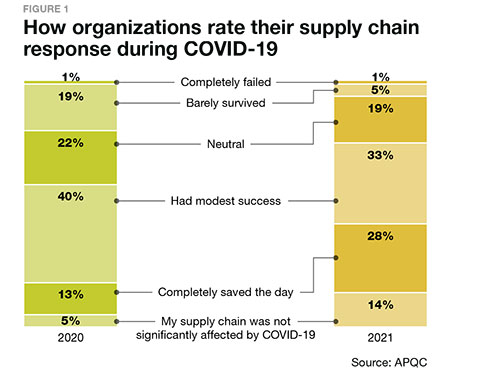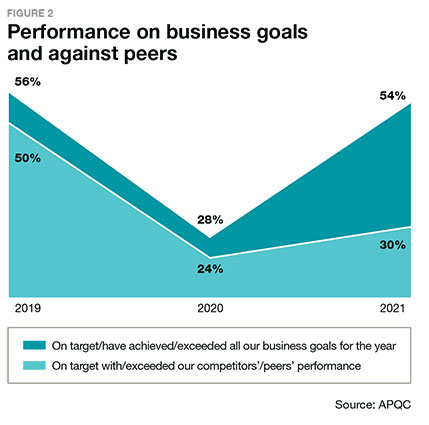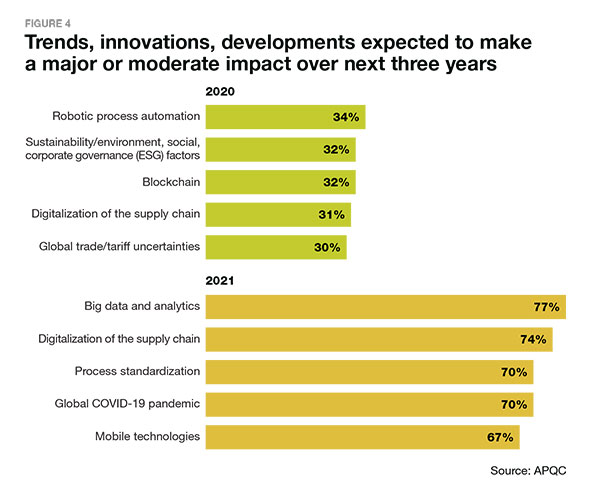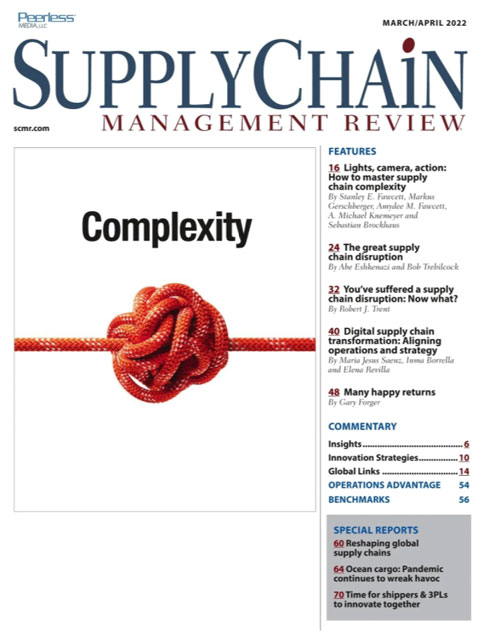Sorry, but your login has failed. Please recheck your login information and resubmit. If your subscription has expired, renew here.
March-April 2022
Yesterday, I hosted a webinar on the steps supply chain leaders are taking to redesign their supply chains to cope with this period of unprecedented demand. Earlier last month, I attended the Manifest conference in Las Vegas. The exhibitors featured a lineup of supply chain startups while the attendee list was dominated by venture capital firms looking to get in on the action in our booming industry. This morning, one of the lead news stories is about another disruption threatening to bring global supply chains to a halt: Browse this issue archive.Need Help? Contact customer service 847-559-7581 More options
At the end of last year, APQC conducted its annual Supply Chain Challenges and Priorities survey. Each year, we survey a group of globally diverse, cross-industry supply chain professionals to learn more about the barriers their organizations are experiencing and their priorities for the coming year. Although the survey respondents differ each year, they provide a valuable set of data that reveals much about the current state of the supply chain.
The results from the 2021 survey indicate that many supply chains are recovering to pre-pandemic performance levels. However, collaboration, further development of analytics capabilities and technology adoption will be critical for long-term success.

View the related APQC Infographic, Going beyond the rebound in supply chain here.
Performance during the pandemic
As shown in Figure 1, supply chains learned from the disruptions they experienced during 2020. By the end of 2021, there was a nine-point jump in the percentage of supply chain professionals who believed their supply chains were not significantly affected by COVID-19.
2021 also saw 15% more supply chains be completely successful in response to the COVID-19 pandemic, and a 14% drop among supply chains that barely survived. The fact that a large majority of supply chains have survived in the face of pandemic-related issues is a cause for celebration, but organizations should also be aware that the constant shifting and reprioritizing needed during the pandemic can be exhausting for supply chain professionals, especially as we now enter the third year of the pandemic.
Business performance
Surviving during the pandemic does not necessarily mean thriving, so APQC looked at how organizations’ performance has fared against their business goals and the performance of their competitors. Interestingly, after a significant drop in 2020 many organizations are almost back to pre-pandemic levels when it comes to meeting their high-level business goals (see Figure 2).

The case is different when it comes to comparing organizations’ performance against that of their competitors. The percentage of organizations that were on target with competitors dropped by more than half in 2020 and made only a modest gain in 2021.
As to business goals, only a little more than half of organizations were achieving or exceeding their goals before the pandemic. COVID-19 has only added to the challenges supply chains have faced such as skills shortages, global trade issues and changing automation.

Achieving targeted goals
The survey results are more varied when we consider whether organizations have achieved specific types of goals. As shown in Figure 3, only sales goals rebounded in 2021 to nearly their pre-pandemic levels.
Although organizations indicated that they bounced back in 2021 in terms of meeting sales goals, they actually performed worse when it came to achieving cost savings goals. This means that increased sales led to increased revenue, but costs were higher and margins ultimately did not improve.
In fact, with the exception of sales and customer satisfaction goals, organizations’ performance has been on a steady decline since the start of the pandemic. This is especially concerning given that most organizations struggled to achieve their goals
even before the pandemic.
Obstacles to moving forward
Each year, APQC’s survey asks supply chain professionals to evaluate the trends, innovations and developments they expect to affect supply chains over the next three years. It also asks respondents to indicate obstacles to and ways to support the improvement of supply chain processes.
Trends affecting supply chains for the near future
Figure 4 presents the top five trends expected to make a major or moderate impact, as indicated by the respondents to APQC’s 2020 and 2021 surveys. As shown in the figure, more respondents in the 2021 survey expect for the trends to make a major or moderate impact on supply chains.

Big Data and analytics, along with digitalization of the supply chain, moved up in the ranks of the top trends named by supply chain professionals. More than three-quarters of APQC’s 2021 survey respondents expect Big Data and analytics to have a major or moderate impact on supply chains in the coming years. This trend was not even among the top five named by respondents to the 2020 survey. During the pandemic, organizations have moved faster on automation projects, resulting in more data to analyze and use for decision making. Faster analysis can enable organizations to quickly adjust to changing conditions, perhaps making the difference between success or failure in an unstable environment.
The increased attention to digitalization is no surprise given the rapid improvements in technology for the supply chain. For instance, the last two years has seen the increased deployment of autonomous vehicles thanks to developments in artificial intelligence. Technology can also help alleviate some of the staffing shortages resulting from the pandemic.
Attention to digitalization has also increased due to the shift to a remote workforce, at least part of the time. This most likely will not change any time soon. A related trend is the importance of mobile technologies, which also jumped into the top five in 2021. More than ever, supply chain professionals must have the ability to work from anywhere, meaning they need access to mobile technologies.
Process standardization is another trend that moved into the top five in 2021. A foundation of solid processes is needed to make all an organization’s other efforts successful. As disruptions continue to affect supply chains, organizations have realized that they can no longer simply react to challenges. They must develop strong business continuity plans to address new COVID-19 variants or other more standard supply chain disruptions.
Not surprisingly, now that it’s clear that a return to normal is a slow process given to fits and starts, a majority of APQC’s 2021 survey respondents indicated that the pandemic would be a trend making a moderate or major impact on supply chains over the next three years. Further, increased demand for shorter shipping distances and more local suppliers will lead to further permanent changes.
Obstacles to and supports for improvement
Respondents were also asked to list the obstacles their organizations face to improving their supply chain processes. In 2020, survey respondents named the amount of change as being the top obstacle. By comparison, the top obstacle named in 2021 was a lack of collaboration both internally and externally. Although supply chain professionals may be getting used to pandemic-led rapid changes, the fact that there is a lack of collaboration is concerning. Collaboration is a factor that organizations can control to a great extent, and it should be one that businesses leverage to their advantage.
Related factors that also made the top five are limited workforce engagement and communication challenges. Encouraging engagement, open communication and working together can be the key to successfully improving supply chain processes.
2022 is the year of planning and analytics
Organizations realize that planning is central to their ability to remain resilient and agile. For the second year in a row, supply chain planning is the top priority for the new year, with 89% of respondents indicating that it is a priority for their companies. When it comes to planning, half of survey respondents said that their organizations will focus on demand planning and forecasting, and about the same amount will focus on analytics and measurement. Yet for demand planning to be effective, organizations will need to improve their collaboration, making it even more important to address engagement and communication.
Tied for second place among supply chain priorities are sourcing and procurement, logistics and inventory management and innovation. In procurement, organizations intend to make automation and digitization a top area of focus. This is not a surprise given the impact that supply chain professionals expect for technology to make in the coming years.
In logistics, organizations intend to focus in the coming year on inventory management and analytics. The attention paid to inventory shortages over the past year has left organizations looking for ways to optimize their stock levels to meet demand. An increased focus on analytics can also help organizations improve their ability to predict changes in demand and the best ways to ship products to customers.
Organizations have made operational and process innovation another top focus area for the year. Businesses are using all the tools at their disposal to improve their processes and achieve greater efficiency. Although supply chains have survived in the face of another pandemic year, businesses recognize that they must be creative to reach their business goals.
If 2021 was the year of mixed results, 2022 is poised to be the year organizations use the factors within their control to forge a new path. Businesses can nurture internal and external collaboration and use a renewed focus on
analytics and technology to exceed pre- pandemic performance.
About APQC
APQC helps organizations work smarter, faster, and with greater confidence. It is the world’s foremost authority in benchmarking, best practices, process and performance improvement, and knowledge management. APQC’s unique structure as a member-based nonprofit makes it a differentiator in the marketplace. APQC partners with more than 500 member organizations worldwide in all industries. With more than 40 years of experience, APQC remains the world’s leader in transforming organizations. Visit us at apqc.org and learn how you can make best practices your practices.
SC
MR
Sorry, but your login has failed. Please recheck your login information and resubmit. If your subscription has expired, renew here.
March-April 2022
Yesterday, I hosted a webinar on the steps supply chain leaders are taking to redesign their supply chains to cope with this period of unprecedented demand. Earlier last month, I attended the Manifest conference in… Browse this issue archive. Access your online digital edition. Download a PDF file of the March-April 2022 issue.At the end of last year, APQC conducted its annual Supply Chain Challenges and Priorities survey. Each year, we survey a group of globally diverse, cross-industry supply chain professionals to learn more about the barriers their organizations are experiencing and their priorities for the coming year. Although the survey respondents differ each year, they provide a valuable set of data that reveals much about the current state of the supply chain.
The results from the 2021 survey indicate that many supply chains are recovering to pre-pandemic performance levels. However, collaboration, further development of analytics capabilities and technology adoption will be critical for long-term success.

View the related APQC Infographic, Going beyond the rebound in supply chain here.
Performance during the pandemic
As shown in Figure 1, supply chains learned from the disruptions they experienced during 2020. By the end of 2021, there was a nine-point jump in the percentage of supply chain professionals who believed their supply chains were not significantly affected by COVID-19.
2021 also saw 15% more supply chains be completely successful in response to the COVID-19 pandemic, and a 14% drop among supply chains that barely survived. The fact that a large majority of supply chains have survived in the face of pandemic-related issues is a cause for celebration, but organizations should also be aware that the constant shifting and reprioritizing needed during the pandemic can be exhausting for supply chain professionals, especially as we now enter the third year of the pandemic.
Business performance
Surviving during the pandemic does not necessarily mean thriving, so APQC looked at how organizations’ performance has fared against their business goals and the performance of their competitors. Interestingly, after a significant drop in 2020 many organizations are almost back to pre-pandemic levels when it comes to meeting their high-level business goals (see Figure 2).

The case is different when it comes to comparing organizations’ performance against that of their competitors. The percentage of organizations that were on target with competitors dropped by more than half in 2020 and made only a modest gain in 2021.
As to business goals, only a little more than half of organizations were achieving or exceeding their goals before the pandemic. COVID-19 has only added to the challenges supply chains have faced such as skills shortages, global trade issues and changing automation.

Achieving targeted goals
The survey results are more varied when we consider whether organizations have achieved specific types of goals. As shown in Figure 3, only sales goals rebounded in 2021 to nearly their pre-pandemic levels.
Although organizations indicated that they bounced back in 2021 in terms of meeting sales goals, they actually performed worse when it came to achieving cost savings goals. This means that increased sales led to increased revenue, but costs were higher and margins ultimately did not improve.
In fact, with the exception of sales and customer satisfaction goals, organizations’ performance has been on a steady decline since the start of the pandemic. This is especially concerning given that most organizations struggled to achieve their goals
even before the pandemic.
Obstacles to moving forward
Each year, APQC’s survey asks supply chain professionals to evaluate the trends, innovations and developments they expect to affect supply chains over the next three years. It also asks respondents to indicate obstacles to and ways to support the improvement of supply chain processes.
Trends affecting supply chains for the near future
Figure 4 presents the top five trends expected to make a major or moderate impact, as indicated by the respondents to APQC’s 2020 and 2021 surveys. As shown in the figure, more respondents in the 2021 survey expect for the trends to make a major or moderate impact on supply chains.

Big Data and analytics, along with digitalization of the supply chain, moved up in the ranks of the top trends named by supply chain professionals. More than three-quarters of APQC’s 2021 survey respondents expect Big Data and analytics to have a major or moderate impact on supply chains in the coming years. This trend was not even among the top five named by respondents to the 2020 survey. During the pandemic, organizations have moved faster on automation projects, resulting in more data to analyze and use for decision making. Faster analysis can enable organizations to quickly adjust to changing conditions, perhaps making the difference between success or failure in an unstable environment.
The increased attention to digitalization is no surprise given the rapid improvements in technology for the supply chain. For instance, the last two years has seen the increased deployment of autonomous vehicles thanks to developments in artificial intelligence. Technology can also help alleviate some of the staffing shortages resulting from the pandemic.
Attention to digitalization has also increased due to the shift to a remote workforce, at least part of the time. This most likely will not change any time soon. A related trend is the importance of mobile technologies, which also jumped into the top five in 2021. More than ever, supply chain professionals must have the ability to work from anywhere, meaning they need access to mobile technologies.
Process standardization is another trend that moved into the top five in 2021. A foundation of solid processes is needed to make all an organization’s other efforts successful. As disruptions continue to affect supply chains, organizations have realized that they can no longer simply react to challenges. They must develop strong business continuity plans to address new COVID-19 variants or other more standard supply chain disruptions.
Not surprisingly, now that it’s clear that a return to normal is a slow process given to fits and starts, a majority of APQC’s 2021 survey respondents indicated that the pandemic would be a trend making a moderate or major impact on supply chains over the next three years. Further, increased demand for shorter shipping distances and more local suppliers will lead to further permanent changes.
Obstacles to and supports for improvement
Respondents were also asked to list the obstacles their organizations face to improving their supply chain processes. In 2020, survey respondents named the amount of change as being the top obstacle. By comparison, the top obstacle named in 2021 was a lack of collaboration both internally and externally. Although supply chain professionals may be getting used to pandemic-led rapid changes, the fact that there is a lack of collaboration is concerning. Collaboration is a factor that organizations can control to a great extent, and it should be one that businesses leverage to their advantage.
Related factors that also made the top five are limited workforce engagement and communication challenges. Encouraging engagement, open communication and working together can be the key to successfully improving supply chain processes.
2022 is the year of planning and analytics
Organizations realize that planning is central to their ability to remain resilient and agile. For the second year in a row, supply chain planning is the top priority for the new year, with 89% of respondents indicating that it is a priority for their companies. When it comes to planning, half of survey respondents said that their organizations will focus on demand planning and forecasting, and about the same amount will focus on analytics and measurement. Yet for demand planning to be effective, organizations will need to improve their collaboration, making it even more important to address engagement and communication.
Tied for second place among supply chain priorities are sourcing and procurement, logistics and inventory management and innovation. In procurement, organizations intend to make automation and digitization a top area of focus. This is not a surprise given the impact that supply chain professionals expect for technology to make in the coming years.
In logistics, organizations intend to focus in the coming year on inventory management and analytics. The attention paid to inventory shortages over the past year has left organizations looking for ways to optimize their stock levels to meet demand. An increased focus on analytics can also help organizations improve their ability to predict changes in demand and the best ways to ship products to customers.
Organizations have made operational and process innovation another top focus area for the year. Businesses are using all the tools at their disposal to improve their processes and achieve greater efficiency. Although supply chains have survived in the face of another pandemic year, businesses recognize that they must be creative to reach their business goals.
If 2021 was the year of mixed results, 2022 is poised to be the year organizations use the factors within their control to forge a new path. Businesses can nurture internal and external collaboration and use a renewed focus on
analytics and technology to exceed pre- pandemic performance.
About APQC
APQC helps organizations work smarter, faster, and with greater confidence. It is the world’s foremost authority in benchmarking, best practices, process and performance improvement, and knowledge management. APQC’s unique structure as a member-based nonprofit makes it a differentiator in the marketplace. APQC partners with more than 500 member organizations worldwide in all industries. With more than 40 years of experience, APQC remains the world’s leader in transforming organizations. Visit us at apqc.org and learn how you can make best practices your practices.
SC
MR


Latest Supply Chain News
- Tech investments bring revenue increases, survey finds
- Survey reveals strategies for addressing supply chain, logistics labor shortages
- Israel, Ukraine aid package to increase pressure on aerospace and defense supply chains
- How CPG brands can deliver on supplier diversity promises
- How S&OP provides the answer to in-demand products
- More News
Latest Podcast

 Explore
Explore
Procurement & Sourcing News
- Israel, Ukraine aid package to increase pressure on aerospace and defense supply chains
- How CPG brands can deliver on supplier diversity promises
- How S&OP provides the answer to in-demand products
- There is still work to do to achieve supply chain stability
- Blooming success: The vital role of S&OE in nurturing global supply chains
- How one small part held up shipments of thousands of autos
- More Procurement & Sourcing
Latest Procurement & Sourcing Resources

Subscribe

Supply Chain Management Review delivers the best industry content.

Editors’ Picks






